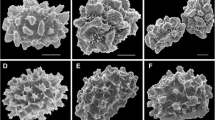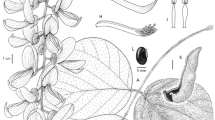Abstract
Microparacaryum (M. Pop. exH. Riedl)Hilger & Podlech is described as a new genus of theBoraginaceae-Cynoglosseae. It comprises the annual species hitherto included inParacaryum (DC.)Boiss. andMattiastrum (Boiss.)Brand. Distribution maps are given for all 3 genera.Microparacaryum consists of two species,M. salsum (Boiss.)Hilger & Podlech (M. s.) andM. intermedium (Fresen.)Hilger & Podlech (M. i.). ParticularlyM. i. is a very variable species, and most of the species formerly recognized belong here. Scattered all over the range of the genus, plants occur with nutlets exhibiting flat or incurved marginal wings, often in mixed populations. This fruit polymorphism is taxonomically treated by recognizing “formae”. In addition, the following new infraspecific taxa and combinations are described:M. i. var.intermedium formaparacaryoides Hilger & Podlech,M. i. var.stellatum (H. Riedl)Hilger & Podlech,M. i. var.stellatum formamattiastroides Hilger & Podlech,M. s. formamattiastroides Hilger & Podlech.
Similar content being viewed by others
Literatur
Barbier, E., Mathez, J., 1973: Contribution à l'étude des Cynoglossées (Boraginacées):Pardoglossum, genre nouveau du Bassin méditerranéen occidental. — Candollea28, 281–323.
Brand, A., 1915: Neue Borraginaceen-Studien III. — Feddes Repert.14, 146–156.
- 1921:Borraginaceae-Borraginoideae-Cynoglosseae. — InEngler, A., (Ed.): Das Pflanzenreich4, 252 (Heft78).
De Candolle, A., 1846:Borraginaceae. — InDe Candolle, A., (Ed.): Prodromus Systematis Naturalis Regni Vegetabilis10, 1–178. — Paris: V. Masson.
Dempster, L. T., 1958: Dimorphism in the fruits ofPlectritis and its taxonomic implication. — Brittonia10, 14–28.
Eggers Ware, D. M., 1983: Genetic fruit polymorphism in North AmericanValerianella (Valerianaceae) and its taxonomic implication. — Syst. Bot.8, 33–44.
Feinbrun-Dothan, N., 1978: Flora Palaestina3. — Jerusalem: Jerusalem Academic Press.
Goloskokov, V., 1975: Sistematičeskie zametki po roduLappula Gilib. Kazahstana (DeLappula Gilib. Kazachstaniae Notae Systematicae). — In: Flora i Rastitel'nye Resursy Kazahstana (Red.G. Z. Bijašev), 69–80. — Alma Ata: „Nauka“.
Greuter, W., (Ed.), 1981: Med-Checklist Notulae, 3. — Willdenowia11, 23–43.
Hilger, H. H., 1981a: Entwicklungstendenzen im Fruchtbau der anemochoren BoraginaceengattungenMattiastrum undParacaryum. — Ber. Deutsch. Bot. Ges.94, 677–687.
—, 1981b: Die Perikarpentwicklung geflügelter Klausen aus demParacaryum-Verwandtschaftskreis (Cynoglosseae, Boraginaceae). — Pl. Syst. Evol.138, 73–88.
—,Richter, U., 1982: Untersuchungen zur Ausbildung der Klausen und ihrer Oberflächenskulpturen beiParacaryum intermedium (Boraginaceae) aus Jordanien. — Beitr. Biol. Pflanzen57, 205–220.
Huber-Morath, A., 1981: Ergänzungen zuP. H. Davis' “Flora of Turkey and the East Aegean Islands” 1–6 (1965–1978). II. — Candollea36, 77–114.
Huxley, J. S., 1955: Morphism and evolution. — Heredity9, 1–52.
Johnston, I. M., 1924: Studies in theBoraginaceae III. — Contrib. Gray Herb. Harvard. Univ. Ser. Nova73, 42–78.
Kazmi, S. M. A., 1970, 1971: A revision of theBoraginaceae of West Pakistan and Kashmir. — J. Arnold Arb.51, 133–184, 367–402, 499–520 (1970);52, 110–136, 334–363, 486–522, 666–690 (1971).
Kürschner, H., 1980: Vegetationsanalytische und physiognomisch-ökologische Untersuchungen in Hochgebirgen Südost- und Zentral-Anatoliens (Aladağları, Erciyes Dağı, Türkei). — Diss. Tübingen.
Lipsky, W., 1910: Contributio ad floram Asiae Mediae III. — Acta Hort. Petrop.26, 453–573.
Migahid, A. M., 1978: Flora of Saudi Arabia1, Dicotyledons; ed. 2. — Riyadh: Riyadh University Publication.
Mill, R. R., 1977:Paracaryum. — InDavis, P. H., (Ed.): Materials for a flora of Turkey, XXXIV. — Notes Roy. Bot. Gard. Edinb.35, 303–308.
—, 1978:Paracaryum. — InDavis, P. H., (Ed.): Flora of Turkey and the East Aegean Islands6. — Edinburgh: Edinburgh University Press.
Mouterde, P., 1978: Nouvelle Flore du Liban et de la Syrie3 (Charpin, A., Greuter, W., Eds.). — Beyrouth: Dar El-Machreq Éditeurs.
Myrzakulov, P., 1975: Species novaParacaryum Boiss. e Karatau. — Bot. Mater. Gerb. Inst. Bot. Akad. Nauk Kaz. SSR9, 30–31.
Pavlov, N. V., 1964: Flora of Kazakhstan7. — Alma Ata.
Podlech, D., Anders, O., 1977: Florula des Wakhan (Nordost-Afghanistan). — Mitt. Bot. München13, 361–502.
Popov, M. G., 1974:Boraginaceae. — InŠiškin, B. K., (Ed.): Flora of the U.S.S.R.19,Tubiflorae. Engl. Übersetzung. — Jerusalem: Keter Publishing House.
Rechinger, K. H., 1951:Borraginaceae Novae Orientales. — Ann. Nat.-Hist. Mus. Wien58, 44–61.
—, 1964: Flora of Lowland Iraq. — Weinheim: Cramer.
—, 1977: Plants of the Touran Protected Area, Iran. — Iran. Jour. Bot.1, 155–180.
—,Wendelbo, P., 1976: Plants of the Kavir Protected Region, Iran. — Iran. Jour. Bot.1, 23–56.
Riedl, H., 1963:Borraginaceae. — InKøie, M., Rechinger, K. H., (Eds.): Symbolae Afghanicae V. — Biol. Skr. Dan. Vid. Selsk.13/4, 183–252.
—, 1967:Boraginaceae. — InRechinger, K. H., (Ed.): Flora Iranica48. — Graz: Akademische Druck- und Verlagsanstalt.
—, 1970: Notizen zur Orient-Flora. Über zwei verkannteParacaryum-Arten der UdSSR. — Österr. Akad. Wiss., Math.-Naturw. Kl., Anz.106, 6–12.
Schäfer, H., 1942: Die Hohlschuppen derBoraginaceae. — Bot. Jahrb.72, 303–346.
Shmida, A., 1978: Relationships betweenParacaryum intermedium andParacaryum boissieri on Sinai, and the generic separation ofParacaryum andMattiastrum (Boraginaceae). — Pl. Syst. Evol.129, 323–326.
Sorger, F., Buchner, P., 1983: Beiträge zur Flora der Türkei IV. — Linzer Biol. Beitr.14, 167–208.
Valentine, D. H., 1975: The taxonomic treatment of polymorphic variation. — Watsonia10, 385–390.
Zohary, M., 1973: Geobotanical Foundations of the Middle East. 2 Vols. — Stuttgart: Fischer.
Author information
Authors and Affiliations
Rights and permissions
About this article
Cite this article
Hilger, H.H., Balzer, M., Frey, W. et al. Heteromerikarpie und Fruchtpolymorphismus beiMicroparacaryum, gen. nov., (Boraginaceae). Pl Syst Evol 148, 291–312 (1985). https://doi.org/10.1007/BF00985930
Received:
Issue Date:
DOI: https://doi.org/10.1007/BF00985930




